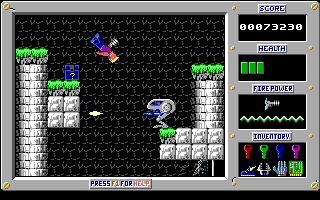Overview
 The titular character in Duke Nukem 3D.
The titular character in Duke Nukem 3D.The Duke Nukem franchise began in 1991 when Apogee Software released the original Duke Nukem, a 2D side scrolling platformer for MS-DOS. Apogee Software, now known as 3D Realms, quickly became one of the best known developers for the computer industry in 1996, with the release of Duke Nukem 3D. One retrospective of the company's history stated that this game almost overnight made 3D Realms a fortune. Since these early games, the Duke Nukem franchise has been one of the most well-known and beloved franchises in video game history.
When Duke Nukem was first released, Apogee discovered that there was a Captain Planet villain with the same name. Fearing a copyright dispute, they changed the name to Duke Nukum with version 2.0 of the game. However, after discovering that "Duke Nukem" was not copyrighted, they copyrighted it and have used the name ever since.
Games
 Duke Nukem was well-known for its fast paced gameplay.
Duke Nukem was well-known for its fast paced gameplay.With several platforming releases like Duke Nukem and Commander Keen, Apogee Software was already making a name for themselves in 1991. Duke Nukem is a traditional platforming game, in which the player must guide Duke Nukem to the end of each level by destroying enemies, collecting points, and navigating the level. In addition to platforming and destroying enemies, players can collect upgrades that improve the quality of Duke Nukem's weapons, increase his maximum health, and even items with special abilities. With a focus on gaining points, it's possible to gain end of the level bonuses that give the player an amount of points for performing special tasks in the game.
 Duke Nukem II was released based on the popularity of the first game.
Duke Nukem II was released based on the popularity of the first game.Based on the popularity of the first game, Apogee Software released Duke Nukem II in 1993. The game is almost identical to the first game, although there are minor differences. The plot of Duke Nukem II involves an alien race known as the Rigelatins, who come to enslave all of earth by capturing Duke Nukem's brain and using it to plan an attack. This same plot was used in the later Game Boy Color platforming game, Duke Nukem. This game, while sharing the name of the first game, is more akin to Duke Nukem II.
 Despite being in 3D, Manhattan Project is a side-scrolling run-and-gun.
Despite being in 3D, Manhattan Project is a side-scrolling run-and-gun.Although the Duke Nukem franchise is more well-known for the first-person shooters, there have been other side-scrolling platformer releases. Duke Nukem: Manhattan Project was released in 2002 for the PC. While Manhattan Project is more of a side-scrolling run-and-gun than a pure action platformer. While not directly connected to the first two games in the franchise, Manhattan Project is very similar, with a villain resembling Dr. Proton from the first game and gameplay akin to the first two games.
With the release of Duke Nukem 3D in 1996, Duke Nukem became a hugely popular franchise, due to a variety of aspects. The humor in Duke Nukem 3D played a large part in its popularity, with rude and controversial humor that was unheard of at the time. The very few real competitors at the time was also a factor in Duke Nukem 3D's large popularity, with only a few other largely popular first-person shooters (such as Quake).
 The Devastator weapon is a dual-wielded rapid fire rocket launcher.
The Devastator weapon is a dual-wielded rapid fire rocket launcher.Duke Nukem 3D plays similarly to earlier first-person shooters such as Doom and Wolfenstein 3D, although it is different in many ways. The game gives players horizontal and vertical control of Duke's vision, differing from earlier first-person shooters. Levels in the game are almost entirely non-linear, although the overall goal remains the same; reach the exit of the level, killing enemies and collecting items along the way. Duke Nukem has an enormous arsenal of weapons at his disposal in order to dispatch aliens, including Ripper/chainguns, shotguns, shrink rays, missile launchers, pipe bombs, rapid fire rocket launchers, and freeze rays. In addition to a single player story mode lasting over a variety of chapters, Duke Nukem 3D has a multiplayer mode which is still used to this day. Being released in the early days of the Internet, Duke Nukem 3D allows players to connect modem-to-modem, battling and chatting in games.
 Duke Nukem Advance shares many of its concepts with Duke Nukem 3D.
Duke Nukem Advance shares many of its concepts with Duke Nukem 3D.The immense popularity of Duke Nukem 3D led to a variety of ports and expansions. Atomic Edition and Plutonium Pak were two expansion packs which contained a new chapter, new enemies, new weapons, and minor changes to the game's script which made it easier to mod. Duke Nukem 3D was also released for the Sega Genesis (only in Brazil), Sega Saturn, PlayStation, Game.com (heavily altered as well as in black and white), Xbox Live, and iPhone. In addition, Duke Nukem 64 was a censored version of Duke Nukem 3D which also included the added content from the Plutonium Pak expansion.
 Duke Nukem Forever in a screenshot from the 2009 build.
Duke Nukem Forever in a screenshot from the 2009 build.In 2002, the Duke Nukem first-person shooter franchise was continued with the release of Duke Nukem Advance on the Game Boy Advance. Duke Nukem Advance is a completely new game, despite using the graphics and sounds from Duke Nukem 3D. Duke Nukem Advance has a new plot and levels, although the gameplay remains largely the same. Despite not expanding on the Duke Nukem formula, the game was a well-received first-person shooter, being compared to other Game Boy Advance games such as Ecks vs. Sever, Wolfenstein 3D, and Doom.
Likely the most well-known game in the Duke Nukem franchise, Duke Nukem Forever, became famous for its unusually extended development cycle. The game was initially announced in 1997, following the immense success of Duke Nukem 3D. It was planned to be a similar first-person shooter, and content has periodically leaked out over the past decade of development. The long development cycle can be blamed on a variety of factors. One interview with an anonymous 3D Realms employee stated the Duke Nukem creator George Broussard was constantly trying to improve the game, purchasing a variety of engines and adding a variety of concepts in order to make "Forever" an incredible game. This led to the team having to often start completely over when using a new engine, and the constant purchases nearly led the company bankruptcy. In addition, the rapidly changing PC market during the late 1990s and early 2000s is a factor, with games shifting from 2D to 3D. Despite the massive hype for the game, 3D Realms was unable to complete the game, shuttering its development staff in 2009.
 Duke Nukem: Time to Kill was one of three third-person action games in the franchise.
Duke Nukem: Time to Kill was one of three third-person action games in the franchise.The game was finally completed by Gearbox Software, Triptych Games and Piranha Games. It was released in 2011 to negative reviews although the game sold fairly well. Duke Nukem Forever is a first-person shooter starring the King himself, complete with his tongue-in-cheek and fourth-wall-breaking one-liners. Naturally, the game's plot follows an alien invasion that Duke must put an end to, through whatever means necessary.
While the Duke Nukem first-person shooter franchise has failed to expand, a series of Duke Nukem third person shooters have been released on the PlayStation and Nintendo 64. The first of these, Duke Nukem: Time to Kill, was released in 1998. The game is a third-person action game in the style of Tomb Raider, with Duke fighting a variety of aliens across four separate time periods. The game had two sequels; Duke Nukem: Land of the Babes on the PlayStation, which preserved the Tomb Raider style game play, and Duke Nukem: Zero Hour on the Nintendo 64, which was more in line with DN3D's fast-paced shooter gameplay and controls despite being a 3rd-person game..
The series is still continuing to this day, with a DS and PSP game planned for release in 2010. Titled Duke Nukem Trilogy, the game will have three Duke Nukem games. These games are titled Critical Mass, Chain Reaction, and Proving Grounds. According to 3D Realms, the games will be "multi-mode," meaning that players can switch from third-person, first-person, isometric, and side-scrolling. At the moment, very little information beyond the game's names and the "multi-mode" has been released.
Log in to comment